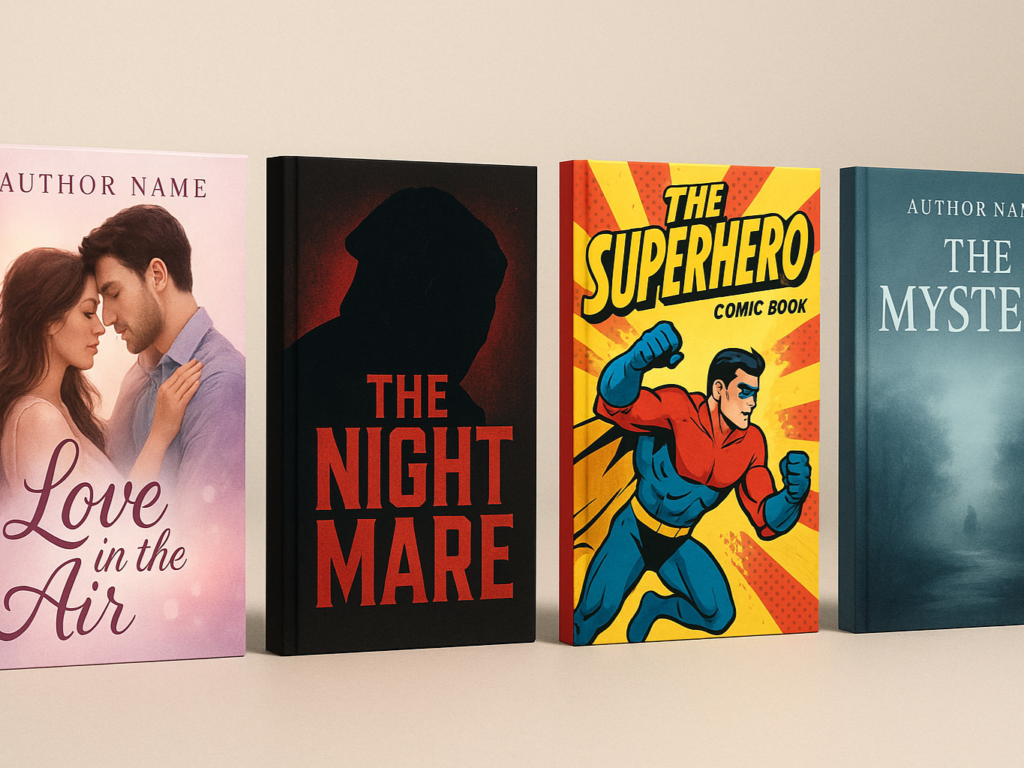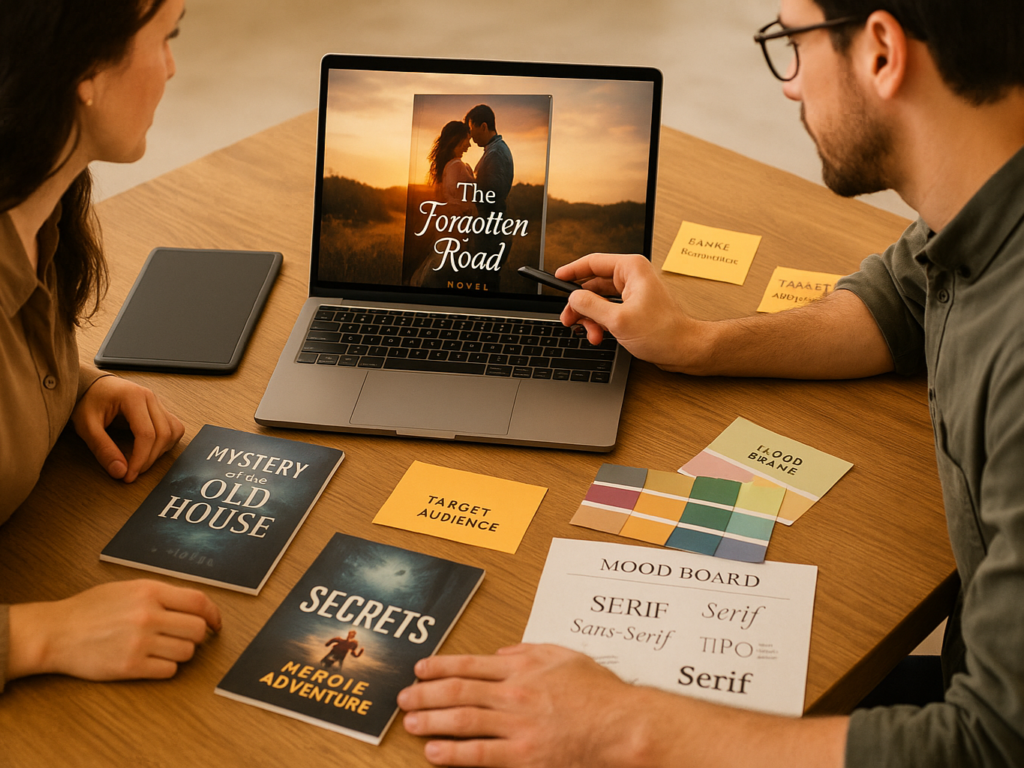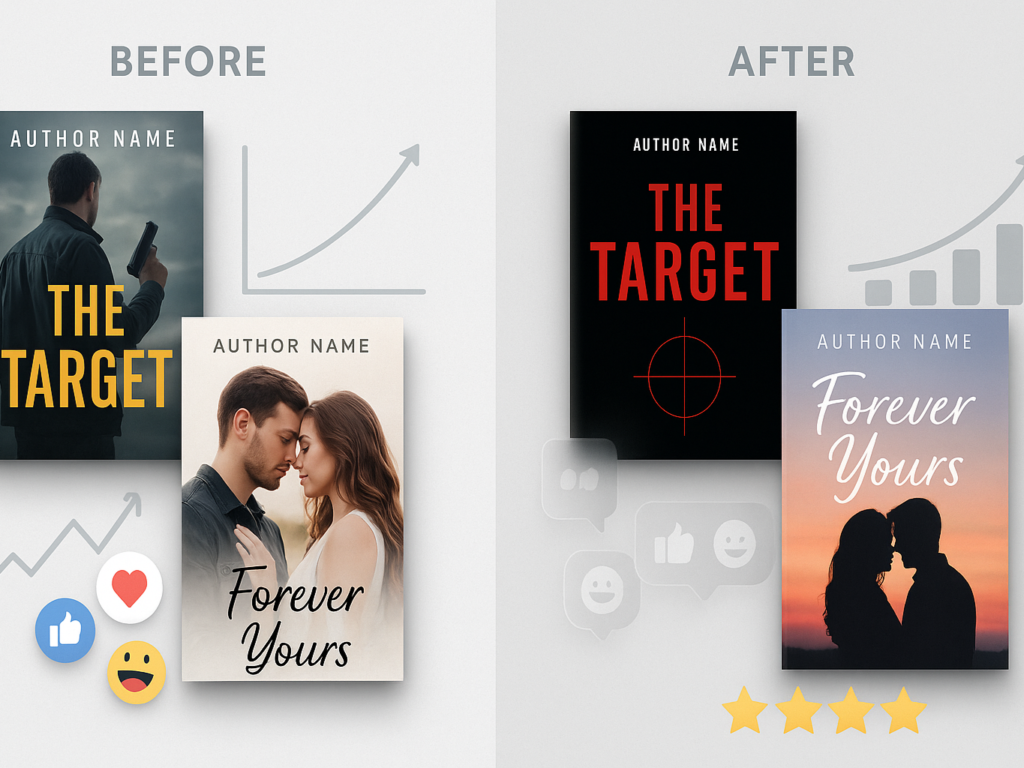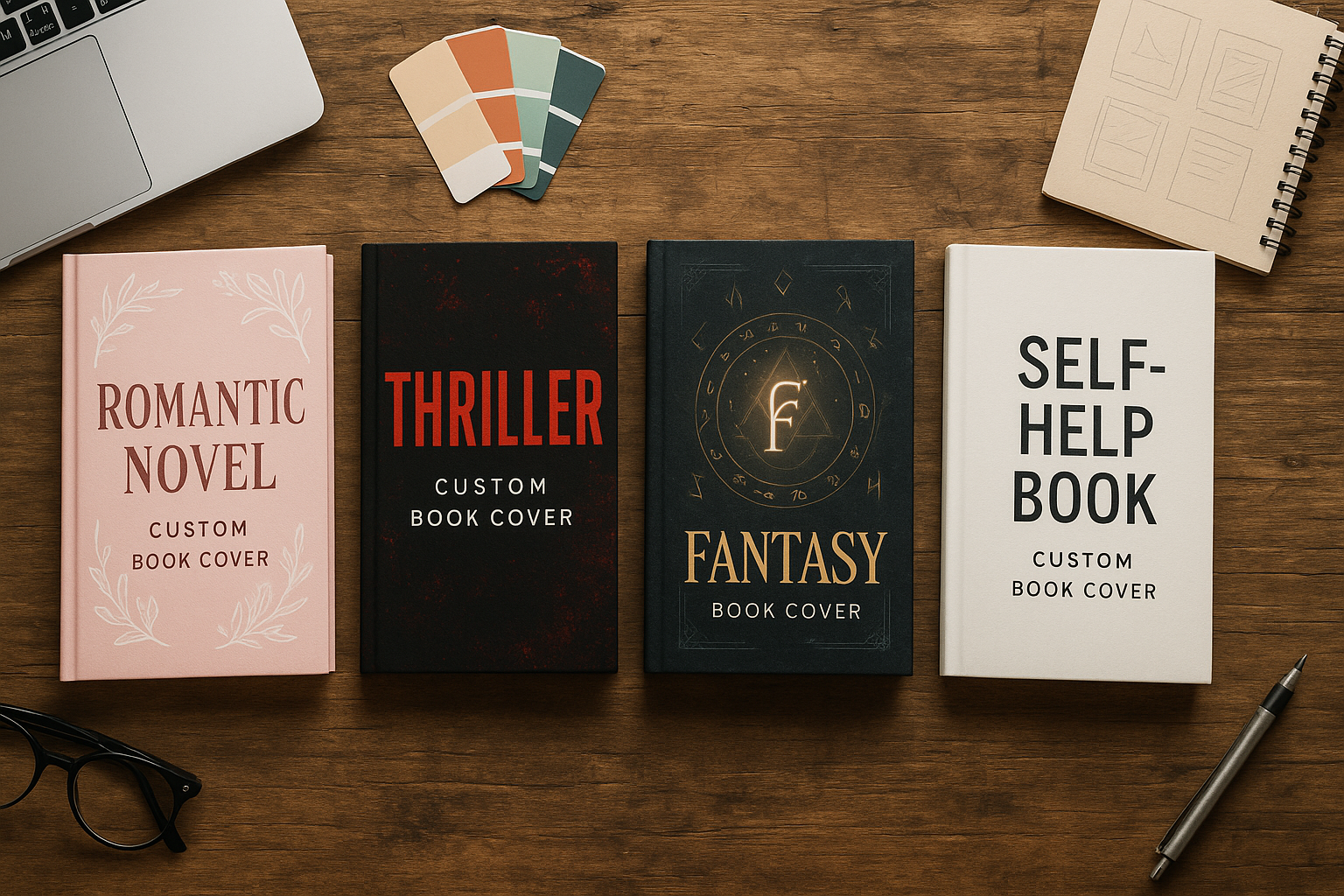Why Your Book Cover Matters More Than You Think
“Ever judged a book by its cover? It’s something we all do!”
In fact, research shows that 75% of people decide whether to pick up a book based on its cover alone. So, if you’re an author hoping to stand out, a custom book cover is no longer a luxury. It’s a necessity. A great cover can draw in readers and increase sales. This is true for Amazon, bookstores, and social media. In contrast, a bland cover might leave your story lost in the crowd.
Custom Book covers shine a light on your Book. Readers notice them even before they turn the first page. But what makes a cover irresistible? And how can you create one without breaking the bank?
In this article, we’ll reveal how to design the perfect cover. We’ll look at budget-friendly options too. Plus, we’ll help you choose between DIY and hiring a pro. Let us dive in!
What Makes a Great Custom Book Cover?

A great custom book cover does more than grab attention. It shapes the reader’s experience and builds an emotional connection. Plus, it captures the story’s essence right away. Here’s a detailed breakdown of the key elements that make a book cover stand out:
1. Typography
Typography is one of the first things a reader notices. The font style should reflect the tone and genre of the Book. A thriller may use sharp, angular fonts to create tension. A romance novel usually uses flowing, cursive fonts. This choice shows elegance and tenderness.
Romance book covers often use soft script fonts. These fonts boost the emotional and romantic feel. Comic book covers often use bold, blocky fonts. The exaggerated lettering helps to capture the action and excitement of the genre.
2. Color
Colour choices are crucial as they evoke emotion. Darker genres like thrillers and horror use deep colours. Shades like black, red, and purple add mystery and danger. For lighter genres like romance, use pastel tones or soft, warm colours. Pinks and gold suggest tenderness and love.
Romance book covers often feature pink, purple, or red shades. In contrast, comic Book covers use bright, high-contrast colours like yellow, red, and blue. These vibrant colours energize the viewer and signal action.
3. Genre Alignment
A custom book cover must immediately communicate the genre to potential readers. Romance book covers often show couples, soft lighting, and flowers. These elements create feelings of love and connection.
Comic book covers often show superheroes in action. They feature dynamic poses, bright colours, and bold lines. This quick genre recognition lets readers see what they’re getting. It shows if it matches their interests.
4. Emotional Impact
The emotional tone of a book should be conveyed through the design. A good cover makes an emotional connection before the reader even opens the Book. A mystery novel often uses dark, shadowy images to create suspense. A feel-good story often uses bright, warm colours and a friendly design to spark happiness.
In romance book covers, the emotional impact is crucial. Small details show love and relationships. A couple’s embrace, soft lighting, and gentle facial expressions all convey deep feelings.
Affordable Options: Custom Book Covers on a Budget
Creating a visually stunning custom book cover doesn’t have to break the bank. Many self-publishing authors think professional covers cost a lot. But that’s not true. You can find custom book covers cheap without compromising on quality. In fact, with a little research, you can secure a high-quality cover for a fraction of the typical $300+ price tag.
1. Budget-Friendly Platforms and Freelancers
Several online platforms and freelance marketplaces offer affordable options for custom book covers. These platforms let you connect with skilled designers at different prices. You can find a style that matches your vision and budget.
- Fiverr: It is a popular marketplace. You can find designers there. They offer custom book covers starting at just $20. Prices differ based on the designer’s experience. However, many top-rated professionals provide quality coverage at affordable rates.
- 99designs: This platform provides a range of pricing options, starting from $199. Though it’s more expensive than Fiverr, you get several design options. This way, you’re sure to find a cover you love.
- Upwork: Freelancers on Upwork offer custom book covers at different price points. Look for designers who create affordable and eye-catching covers for indie authors. Just search carefully!
2. Premade vs. Custom vs. DIY Covers
When it comes to custom book covers, you typically have three main options: premade, custom, or DIY. Each option has its pros and cons.
- Premade Covers: These are ready-made designs you can buy. You can add your book title and author name to personalize them. They’re typically the cheapest option, with prices ranging from $30 to $100. However, since these covers are not unique, there’s a risk that other authors might use the same cover.
- Custom Covers: Custom covers are designed specifically for your Book. The cost usually starts at $100. It can increase based on the designer’s experience and the design complexity. A custom cover ensures originality and a design tailored to your cookbook’s theme and genre.
- DIY Covers: If you have design skills, making your own cover can save money. Try using platforms like Canva or BookBrush. DIY covers are the cheapest option, as many of these tools are free or offer low-cost plans. If you lack design experience, getting a professional look can be tough. You should learn a bit first.
Not all great custom book covers have to cost $300+. You have many budget-friendly options. You can choose premade, custom, or DIY. If you want custom book covers on a budget, check out Fiverr and Upwork. They offer affordable, professional designs. You can also find premade options that won’t break the bank. Choose an option that matches your brand and genre. This helps make a great first impression on your readers.
Best Custom Book Cover Generators (Free & Paid)

Creating a custom book cover doesn’t always have to mean hiring a designer or breaking the bank. Authors can now use custom book cover generators to design professional covers. This way, they save money and time, avoiding high costs. Below are some of the best tools, both free and paid, to help you design the perfect cover for your Book.
1. Canva
Canva is one of the most popular design tools available, and for good reason. Its drag-and-drop interface is super easy to use. It includes many templates and stock photos so that you can create a beautiful custom book cover. Whether you’re a beginner or an experienced designer, Canva is user-friendly and intuitive.
Pros:
- Offers a range of free and premium templates for eye-catching book covers. These templates fit many genres and styles. Every author can find their perfect match easily.
- Offers a wide collection of top-notch stock photos, unique icons, various fonts, and design elements. These resources boost your project and offer endless creative options for customization.
- This platform is simple and easy to use. You don’t need design experience to create professional designs. It’s perfect for anyone who wants to design quickly and easily.
- Provides a free version with basic tools. It also has a paid plan that offers extra features. This gives users the choice to find the best option for their needs.
Cons:
- The software has few customization options compared to advanced design tools. This can limit creativity and make it hard to create unique designs that fit personal preferences.
- Without proper customization, some designs may seem generic. They might lack uniqueness and fail to convey the brand’s message or identity.
2. BookBrush
BookBrush is a tool designed specifically for authors. It focuses on creating high-quality book covers and promotional materials. With BookBrush, you can easily create 3D book mockups, which are great for marketing your Book on social media.
Pros:
- These templates are meticulously crafted to cater specifically to the unique requirements of striking and professional Book covers that capture readers’ attention and enhance the overall appeal of your publication.
- The package features a set of powerful tools that enable users to design stunning 3D book mockups and engaging promotional images, perfect for marketing and showcasing their literary creations effectively.
- The service provides a range of options, including a robust free version for those just starting, as well as premium versions that unlock advanced features for more experienced users.
Cons:
- The free version offers a limited selection of templates and features, restricting users from accessing the full range of creative options and tools necessary for a more comprehensive design experience.
- Certain advanced design functionalities are exclusively accessible through the paid plan, meaning users must upgrade to unlock these enhanced capabilities and fully realize their creative potential.
3. Placeit
Placeit provides an easy-to-use online platform that offers an extensive collection of book cover templates. It’s perfect for authors who want a professional-looking cover quickly and with minimal effort.
Pros:
- Explore a vast selection of thousands of customizable templates, ensuring you find the perfect design that resonates with your vision and meets your specific needs for any project.
- The user-friendly interface is designed specifically for beginners, making it easy to navigate while providing helpful features that enhance the overall creation experience without overwhelming complexity.
- With a streamlined process, you can quickly and effortlessly create a stunning cover in just a few minutes, allowing you to focus more on your content and creativity.
Cons:
- There are few options available for customization, which may not meet the diverse needs and preferences of all users seeking a tailored experience in their design choices.
- Users must pay for each cover, or they can subscribe for complete access to all available features, which may be a financial consideration for some.
4. DIYBookCovers
DIYBookCovers is a free tool that allows authors to design their book covers. The tool is very straightforward, providing a guided step-by-step process to create a cover that fits your Book.
Pros:
- Completely free to use, ensuring that anyone can access and utilize the platform without any financial barriers or hidden costs, allowing for creativity to flourish without constraints.
- Easy to navigate, featuring a user-friendly interface and a straightforward design process that empowers users of all skill levels to create impressive designs effortlessly and efficiently, enhancing their overall experience.
- Offers an extensive collection of free images and fonts, providing users with a diverse range of high-quality resources to incorporate into their designs, enriching their creative projects, and elevating their work.
Cons:
- There are constraints on how much you can customize and design your project, limiting your ability to fully and creatively express your unique vision in the final product.
- The outcomes produced might lack the refinement and professionalism that typically come from using premium services, potentially leading to a less impressive overall appearance or functionality.
Custom Book Cover Generator vs Hiring a Designer
Using a custom book cover generator is a great option for authors on a budget, offering an affordable and user-friendly solution for creating a cover. However, these tools may not allow for the level of customization that a professional designer can provide, which can result in a less unique cover.
On the other hand, hiring a professional designer ensures a tailored, high-quality cover that aligns with your Book’s genre and message. While this is a more expensive option, the result is often far more polished and distinctive.
The custom book cover generators like Canva, BookBrush, Placeit, and DIYBookCovers are excellent tools for authors looking to design their Book covers on a budget. However, if you want a truly unique and professional cover, hiring a designer may be the way to go.
Custom Book Covers by Genre: What Works Best?
Each book genre has its own unique style and design elements that appeal to its target audience. When you design a romance book cover, a comic book cover, or a paperback cover, it’s key to know what visuals appeal to readers. Below, we break down what works best for each genre to help you create a captivating cover.
1. Romance Book Covers
Romance book covers are all about evoking emotions, intimacy, and connection. These covers often use soft, romantic colours. They have elegant fonts and images that show the story’s emotional depth.
What Works Best:
- Soft tones: Use pastel shades like pink, lavender, and peach. These colours show warmth, love, and tenderness.
- Elegant fonts: Flowing, cursive-type fonts give a sense of sophistication and romance.
- Emotional imagery: A couple in a close embrace, a beautiful backdrop, or moments like hand-holding and a gentle kiss.
Popular Trends:
- Couple silhouettes: Simple but striking, these designs often show the outline of a couple in a tender moment, leaving room for the viewer’s imagination.
- Floral accents: Delicate flowers like roses or peonies can symbolize love and beauty, adding an extra touch of romance to the cover.
Example: Romance book covers often feature soft backgrounds with a single, powerful image of a couple, giving it a personal and intimate feel.
2. Comic Book Covers
Comic Book covers, on the other hand, are designed to stand out with bold, high-impact visuals that attract fans of action, adventure, and fantasy. The cover needs to reflect the excitement and tone of the comic inside.
What Works Best:
- Bold fonts: The title should be large and dramatic, often in bright, eye-catching fonts that grab attention.
- High-contrast colour palettes: Use bold, primary colours like red, blue, and yellow to create high contrast and make the cover pop.
- Action shots: Comics show dynamic poses, heroic stances, and intense action scenes. These elements quickly capture the genre’s high-energy feel.
Example: Comic Book covers typically showcase a hero in mid-action or facing off against an antagonist, with exaggerated, comic-style colours that bring the character’s world to life.
3. Book Covers for Paperback Books
Book Covers for Paperback Books are unique because they need to look appealing not only on digital platforms but also on physical shelves. A well-designed paperback cover includes all aspects of the Book, from the front cover to the spine and back cover.
What Works Best:
- Spine design: The spine needs to be clear and readable, especially if the Book is part of a series. A unique font and design make the spine stand out on a bookshelf.
- Back cover blurb layout: The back cover is where you can give potential readers a taste of the story. The text should be easy to read, with a clear, concise blurb that captures the essence of the Book.
- Bleed margins: Ensuring that the cover image extends all the way to the edge, especially for printed books, is essential. This avoids any awkward white borders when the Book is printed.
Example: For paperback books, the front cover pairs with a nice spine design. The back cover is tidy and includes a catchy blurb and author bio.
When you design a custom book cover, make sure to fit the genre. Romance book covers need to spark emotion and intimacy. Comic book covers should feature bold and energetic designs. Paperback book covers must have a polished, professional look for both digital and print. Knowing these genre elements helps your Book shine and reach the right readers.
Tips for Working with a Designer for a Custom Book Cover

Creating a custom book cover can be an exciting yet complex process. Clear communication and teamwork with a designer are essential. They help bring your vision to life. Here are some helpful tips to make sure you get the best possible results from your designer:
1. What to Communicate to Your Designer
When you contact a designer, give them plenty of details about your project. The more you share, the better they can capture your Book’s essence. This helps them design a cover that matches your vision. Here are some key elements to communicate:
- Genre: The genre of your Book plays a big role in the cover design. Whether it’s romance, mystery, fantasy, or nonfiction, each genre has its visual language. Make sure to let your designer know what genre your Book falls into so they can use the appropriate elements.
- Mood/Emotion: Think about the mood or emotion you want the cover to convey. Should it feel light-hearted, mysterious, dark, or romantic? The colour scheme, imagery, and typography should reflect this emotional tone.
- Target Audience: Who is your target audience? Knowing this will help the designer create a cover that resonates with the readers you’re trying to attract. For example, a YA fantasy cover would likely look different from an adult literary fiction cover.
- Comps: Share examples of covers you admire, also known as “comps.” These could be covers from other books in the same genre or any design elements you find appealing. This helps the designer understand your taste and aesthetic preferences.
2. How to Review Drafts and Give Feedback
Once your designer has created a draft, it’s important to provide constructive feedback to ensure that the cover aligns with your vision. Here are a few tips for reviewing and giving feedback:
- Be clear: If you like or dislike part of the design, like the typography, image, or colours, explain your reasons. Give clear feedback. Instead of saying, “I don’t like it,” try, “The font feels too modern for my historical fiction. Can we use something more classic?”
- Stay open-minded: While it’s important to communicate your preferences, trust the designer’s expertise. They might suggest something you hadn’t thought of that could improve the design.
- Make it a conversation: Collaboration is key! Encourage dialogue with your designer, ask questions, and be open to their suggestions. Remember, they are experienced in what works and what doesn’t.
3. Where to Find Experienced Cover Designers
Finding the right designer is crucial to getting a cover that truly represents your Book. Here are a few places to find experienced book cover designers:
- Freelance Platforms: Websites such as Upwork, Fiverr, and 99designs provide many freelance designers. You can find designers with different skills and prices. Look for designers with a portfolio that reflects the style you’re after.
- Referrals: Ask fellow authors, especially those in your genre, for recommendations. Word of mouth is a great way to find a designer who has a track record of producing high-quality work.
- Design Agencies: If your budget is larger, think about hiring a design agency that focuses on book covers. These agencies usually offer more services. They may also provide extra marketing materials.
- Social Media & Forums: Platforms such as Instagram, Behance, and Facebook groups for indie authors often display designers’ work. Look for designers who match your style. Check out their portfolios and reach out to them.
To create a custom book cover, you need to communicate clearly and work together with a designer. Share your genre, mood, audience, and preferences. This helps your designer create a cover that matches your vision. When you review drafts, give clear feedback. Also, be open to the designer’s expertise.
Mistakes to Avoid with Custom Book Covers
Making a custom book cover is key to helping your Book stand out. But it’s easy to make mistakes that harm its appeal. Here are some common pitfalls to avoid when designing your cover:
1. Using Too Many Fonts
One common mistake authors make is using too many fonts on a book cover. It may be tempting to use many fonts, but this can make your design look cluttered and unprofessional. Too many fonts can confuse readers and take away from the clarity of the title and the author’s name.
Solution: Stick to two or three fonts at most. One for the title, one for the author’s name, and another for a tagline or subtitle, if needed. Choose fonts that complement each other and maintain readability.
2. Ignoring Your Genre Expectations
Every genre has a specific set of visual conventions that readers expect from a book cover. A romance novel cover often has soft colours and elegant fonts. In contrast, a thriller cover uses darker shades and bold type. Ignoring these conventions can confuse potential readers and fail to capture their attention.
Solution: Study book covers in your genre to understand the common design elements. Ensure your cover meets these expectations but also stands out as unique.
3. Poor image resolution or copyright issues
Low-resolution images or images that you do not have the rights to can severely damage your cover’s appearance and legality. A blurry image can make your Book seem unprofessional. Also, using copyrighted images without permission can cause serious legal problems.
Solution: Always use high-resolution images (at least 300 DPI) for your cover. If you’re using stock images, ensure that you have the proper licenses or permissions. If you’re hiring a designer, make sure they use licensed images or custom illustrations.
4. DIY without a clear concept
DIY book cover design tools like Canva and BookBrush are user-friendly. However, jumping into design without a clear idea can result in a messy outcome. Without a defined vision for your cover, you risk creating something that doesn’t properly represent your Book or genre.
Solution: Before you start designing, take the time to clarify the mood, tone, and themes of your Book. Make sure you have a solid idea of the message you want the cover to convey, whether it’s through colour, typography, or imagery. If you’re unsure, consider consulting with a professional designer.
Avoiding these mistakes is key to designing a custom book cover. This way, you can capture your Book’s essence and attract your target audience. Keep fonts simple. Stick to genre conventions. Use high-quality, licensed images. Always have a clear concept before starting the design process. By steering clear of these common pitfalls, your cover will shine and help attract the right readers.
Real Author Case Studies: The Impact of Custom Book Cover Redesigns

A custom book cover is more than just a visual element. It’s a powerful marketing tool that can make or break a book’s success. Here are two real-life examples of indie authors. They saw a big jump in sales and engagement after redesigning their book covers.
1. Before and After: A New Look for “The Dark Truth”
Author Sarah Williams, an indie thriller writer, first released The Dark Truth with a plain cover. It didn’t connect with her target audience. The cover had boring fonts and stock images. They didn’t capture the suspense and intrigue of her story. Sales were steady but not stellar.
After consulting with a professional designer, Sarah revamped the cover. The new design had bold colours and sharp fonts. It also featured a minimalist, eerie image that set the thriller’s tone. The transformation was striking.
Results: After launching the new cover, Sarah noticed a 45% increase in sales within the first month. Her Book caught the attention of some new book clubs. Readers loved the eye-catching cover on social media. This buzz helped boost its exposure even more.
2. Before and After: Romance Redesign for “Heart’s Desire”
Indie romance author Emma Carter wrote a book called Heart’s Desire. It was well written, but it didn’t do well. The original cover showed a common photo of a couple. It had no unique features, so readers didn’t find it appealing. The cover failed to show the emotional depth and subtle tension that are key to romance novels.
Emma worked with a designer who focused on romance book covers. Her new cover has soft pastel colours, elegant fonts, and a subtle image of a couple silhouetted by a sunset. It perfectly captures the emotional journey her readers will experience.
Results: In just weeks, Emma’s sales shot up by 70%. The Book also gained attention on many romance blogs. Readers in reviews said the new cover excited them to read the Book. Also, social media shares of the cover helped it grow naturally. Emma received many messages from readers who felt a strong emotional connection to the cover.
3. Quotes from authors about the impact of a new cover
- Sarah Williams: “The redesign of my Book’s cover completely changed the way readers viewed my work. It made my Book stand out in a crowded market and finally captured the true essence of my story.”
- Emma Carter: “I never realized how much a cover could affect a book’s success. After I changed to a design that fits the genre, my sales went up. My readers felt the cover truly matched the love story I wrote.”
These case studies prove that a custom book cover redesign can have a profound impact on sales and reader engagement. Indie authors should invest in a good cover that fits their genre. This choice is not just about looks; it can help them stand out and sell more books.
Final Comparison Table: DIY vs Premade vs Pro Designer
| Method | Best For | Tools Needed | Design Freedom | Cost |
|---|---|---|---|---|
| DIY | Early-Stage Authors | Canva, BookBrush | Medium | Free-Low |
| Premade | Budget-conscious | None | Low | $30-$100 |
| Pro Custom | Serious indie publishers | Freelancer or agency | Hight | $100-$500+ |
1. DIY (Do It Yourself)
- Cost: DIY book covers are free or low-cost, depending on the tools and resources used. Platforms like Canva and BookBrush allow authors to design their covers with little to no expense.
- Best For: This method is best suited for early-stage authors with limited funds or those exploring design before investing in a professional cover. DIY options let authors get started quickly.
- Tools Needed: Popular design tools like Canva or BookBrush are ideal for DIY covers. These platforms are user-friendly and provide templates and customizable features, making them great for beginners with no design experience.
- Design Freedom: DIY covers offer medium design freedom. While authors have control over elements like fonts and colours, achieving a polished, professional look may be difficult without graphic design expertise.
2. Premade
- Cost: Premade book covers typically cost between $30 and $100, making them affordable compared to custom designs. This price range allows authors to access a design that’s already created for a specific genre.
- Best For: This option is perfect for budget-conscious authors who need a quick, professional-looking cover. It’s ideal for those who don’t have the time or resources to design a custom cover but still want a unique look.
- Tools Needed: No design tools are required for premade covers. Authors simply browse existing designs, select one that fits their Book’s theme or genre, and make necessary text changes.
- Design Freedom: Premade covers offer low design freedom. The cover is pre-designed, so customization is limited to adjusting text and colours or adding a few minor tweaks, but the overall design remains fixed.
3. Pro Custom
- Cost: Custom book covers from professional designers generally range from $100 to $500+, depending on the designer’s experience, reputation, and the complexity of the project. This is the most expensive option but ensures a high-quality result.
- Best For: Pro custom covers are ideal for serious indie publishers or authors who want to invest in a unique, polished design that aligns perfectly with their brand and appeals to their target audience.
- Tools Needed: To create a professional custom cover, authors work with freelancers or agencies that specialize in book cover design. The designer handles all the technical aspects and tailoring based on the author’s preferences.
- Design Freedom: With a pro custom cover, the design freedom is high. The author can communicate specific preferences, genre, mood, and audience details, and the designer will craft a cover that is unique and tailored to the Book.
This comparison table highlights the key differences between DIY, premade, and professional custom book covers, helping authors make informed decisions based on their budget, experience, and design needs.
Conclusion: Your cover is the first promise to the reader.
Your book cover is more than just an image; it’s the first promise you make to your readers. It’s the visual representation of your story and sets the tone for what’s to come. A great cover grabs attention and sparks curiosity. It helps you stand out in a crowded market. Getting a custom book cover boosts your Book’s success. It captures your story’s essence and draws in readers.
Design your cover or hire a pro. Either way, make sure it shows the genre, mood, and tone of your Book. If you’re on a budget, many affordable options are available. You can choose premade covers or use budget-friendly design tools. For a unique and professional look, work with a skilled designer. They can boost your Book’s appeal.
Custom book covers are key. They attract your target audience and create a lasting impression. So, don’t underestimate the power of a great design! Need help finding an affordable custom book cover designer? Check out our handpicked recommendations.



